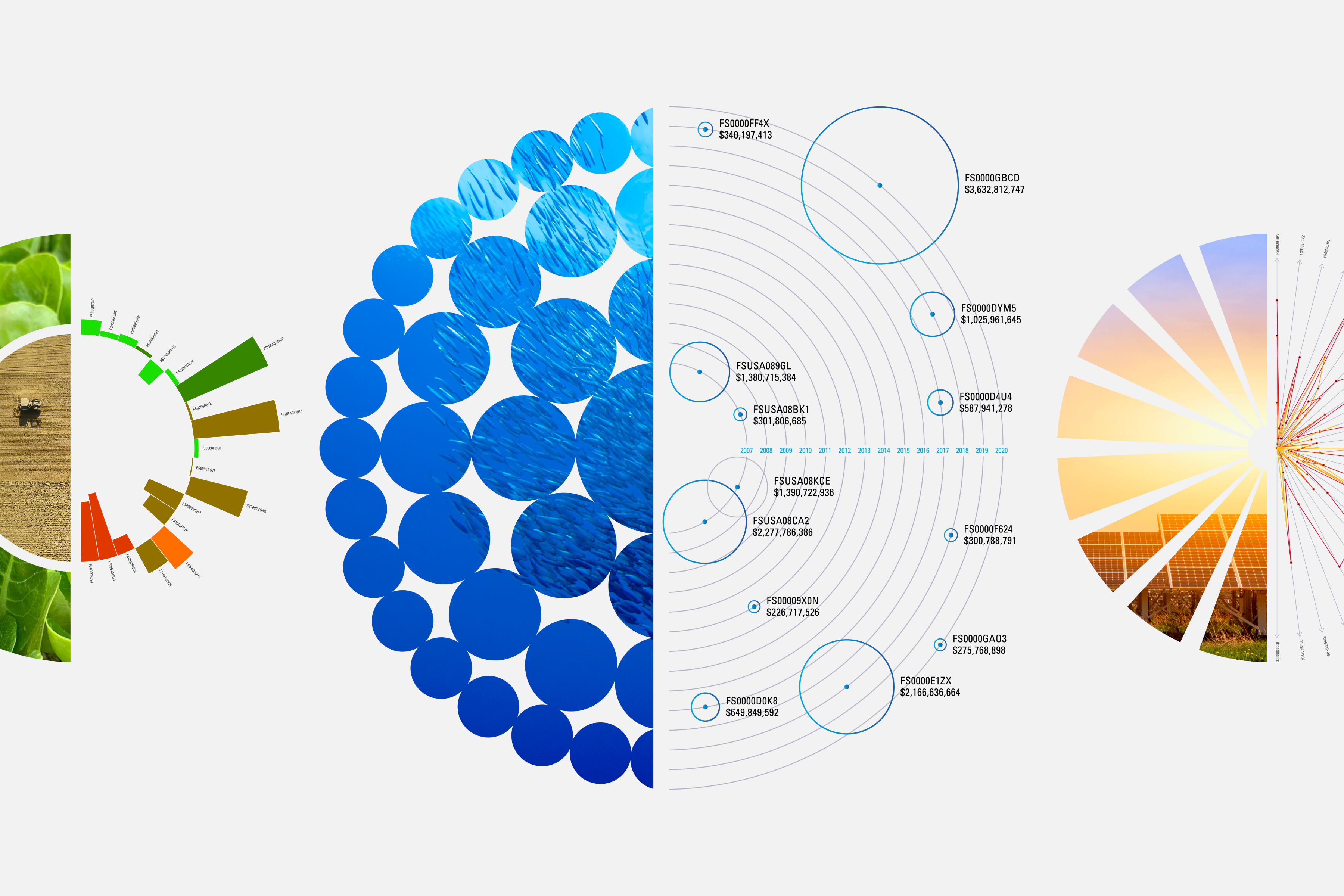
Here’s a scary statistic: Water demand might actually exceed supply by 56% by 2030. Today, 85% of wastewater worldwide is leaving facilities, households, and farms untreated because of a lack of water infrastructure, public financing, or proper regulatory compliance. That isn’t good news, since climate change is already exacerbating who has access to this life-giving, irreplaceable resource.
Businesses and their supply chains rely on water, too. But they are facing increasing competition with each other, and with communities and ecosystems, for water, especially at locations with high or severe water stress. According to the World Bank, failure to implement better water-management policies has the potential to reduce spur migration and spark conflict. For investors, this means that water is a crucial sustainability issue to watch.
Despite the paramount importance of water, the risks that water scarcity or poor quality pose to economies and businesses have received less attention from investors than they deserve, when compared with carbon. The same alertness that is paid to carbon emissions is needed for the water side of the equation. Water plays a key role in meeting the goals of the Paris Agreement and in supporting science-based global climate action. The Intergovernmental Panel on Climate Change reports that 3 billion people could face physical water scarcity with 2C of global temperature rise. That will affect Africa and other climate-vulnerable regions acutely. During Egypt’s COP27 presidency, you might expect a focus on water and climate adaptation as key priorities for multi-stakeholder actions and partnerships between governments, businesses, innovators, and other important actors.
We shared our views and suggested approaches in a previous article last year, where we presented a handful of useful metrics that investors can use to determine a company’s reliance on water in its operations, and how the location of a company’s operations further influence the level of water-related risk it faces. As disclosures have improved over the past year, we can revisit this framework to better understand which industries face the greater related risk.
Improving Water-Related Disclosures Will Be Key for Investors
Inconsistent disclosure practices—and in many cases an outright lack of disclosure—by companies regarding their use of water has compounded the measurement problems related to this critical issue. That presents challenges to investors seeking to fully comprehend water-related risk.
However, disclosure is improving. For example, 16.6% of companies within Sustainalytics’ global coverage disclosed data on water withdrawal in fiscal 2020/2021, compared with only 7% we reported on last year. Similarly, some 12.3% of companies now disclose water consumption, versus only 3% of companies previously. We attribute this general improvement partially to drivers such as the growing awareness of water risks; more-severe extreme weather events in North America, Europe, and Asia-Pacific; as well as more stringent regulatory frameworks such as the EU Taxonomy and SFDR that require both investors and issuers to report more consistently on ESG issues.
How Much Water Risk Does Each Industry Carry?
Companies in the same industry tend to share similar business models, and for those industries, clear water-risk exposure patterns emerge. Based upon reported water metrics, the most water-intensive industries are utilities (including renewable power production, multi-utilities, and electric utilities), paper and pulp, diversified chemicals, diversified metals, and mining firms. For these industries, water is likely to pose a greater risk to shareholder value.
Other industries are less obvious. They might make products with high water content—soft drinks, beer, wine and spirits, and household products come to mind. These rank close to the middle of the pack in our ranking of water-intensity-based benchmarking of sub-industries.
Why so low? Partly because of product innovation. These thirsty sub-industries, which include consumer-products companies, spend more on R&D as a way of avoiding reputational risks through new technologies and developing more socially and environmentally conscious solutions. These efforts have reduced the water intensity of the companies’ operations. They have also led to new products that are less water-dependent. For example, beauty companies have historically relied on water as a main input for shampoo, foundation, or lotions, as well as a coolant during the manufacturing process. But these traditionally bottled liquid products can be overhauled into solid forms such as bars, reducing the water used (alongside lower packaging and emissions, too).
However, these complex business models also frequently source raw materials or products with relatively high water footprints (that is, the amount of water used to produce goods and services). So, while the sub-industries’ water risk from their direct operations is limited, there are related risks embedded into their supply chains.
How to Identify Water Risks in Your Investments
The Valuing Water Finance Initiative, signed by over 60 investors representing $9.8 trillion in assets under management, has pledged to conduct conversations with the most water-intensive companies to protect freshwater systems and act upon the most-striking water challenges at scale.
Water risks faced by individual companies go beyond the industrywide business model and include localized physical, regulatory, and reputational water conditions. Here, the Sustainalytics’ ESG Risk Rating is an ideal resource for investors who seek to better understand the risk that water poses to individual stocks. At the core of the ESG Risk Rating is the identification of material ESG issues, or MEIs, that present a risk to the enterprise value of each company that Sustainalytics covers.
Water-related ESG risks are the major contributor to the Resource Use MEI and the related Resource Use Supply-Chain MEI, and partially contribute to the Emissions, Effluents, and Waste MEI. These are three of the 20 MEIs that Sustainalytics monitors across a universe of nearly 8,400 companies. Within this coverage cohort, Resource Use is currently viewed as material for 28% of companies. Meanwhile, Resource Use— Supply Chain is a material issue for 6.5% of firms and Emissions, Effluents, and Waste is material for 34% of companies.
To broaden understanding of the severity and likelihood of these types of localized sources of water risks, we also advocate using resources like the Water Risk Filter tool, developed by the World Wildlife Fund. This tool can help you assess localized water risk by providing physical, regulatory, and reputational water-risk scores.
Still, investors need to continue to insist on higher-quality, standardized water disclosures from publicly listed companies. As highlighted above, despite improving disclosure, basic metrics like water withdrawal and consumption remain sparse and incomplete at the corporate disclosure level, let alone within supply chains.
What the Net Zero Transition Could Mean for Companies’ Water Risk
Water systems are major sources of global greenhouse gas emissions. By way of example, the GHG emissions of global water utilities equal those of the shipping industry. Increasingly uncertain water supplies are further driving the demand for energy-intensive, predictable water supply approaches like desalination.
Other emissions-heavy sectors are dependent on water. One sector is key to a sustainable energy transition: Water risks run throughout the electric vehicles manufacturing chain.
For example, the growth of the EV market drives the need for batteries, which are projected to account for over 90% of lithium demand by 2030. Lithium mines are typically located in highly water-stressed regions, such as the so-called Lithium Triangle (Chile, Argentina, and Bolivia) or in Australia, which can further increase exposure to water-related physical, regulatory, or reputational risks.
EV manufacturing also depends on the availability of chips, since an EV contains twice as many such components compared with conventional vehicles. Here we see two key risk drivers. For one, the wafer fabrication process is highly water-intensive, and relies on ultrapure water in particular. Second, similar to lithium mining, the location of semiconductor factories is typically in regions that have experienced severe physical water risks in Asia-Pacific, such as China or Taiwan.
Climate change is further multiplying existing water risks. It will require public water policies and institutions to ensure strong governance systems that can respond to the needs of both urban and rural populations, as well as businesses. All of these rely on public water supply. For automakers, disruptions in the supply of batteries could mean the inability to deliver vehicles on time. Companies that perform supply-chain-focused water risk assessments and implement strong supplier programs are better placed to mitigate related risks.
3 Companies Managing Water Risks
With knowledge of a company’s business model and location, one can appreciate the extent of water risk it may face. But should investors integrate such insights into the investing process, especially for those who are looking to contribute to the net zero transition?
To address this using real-world examples, we can look at the automotive sector and its complex supply chain: a manufacturer (Tesla TSLA), a lithium supplier (Sociedad Quimica Y Minera De Chile SA ADR SQM), and a chip provider (Taiwan Semiconductor Manufacturing TSM).
To be sure, being conscious of risk in all its forms remains key to investment success. A company with low water risk doesn’t necessarily make for a good investment. Rather, a stock’s price relative to its fair value—which should factor in all the forms of risk that a company faces—remains key to selecting stocks that are likely to outperform the market.
Tesla
The business model of narrow-moat Tesla isn’t highly water-intensive, although some regions where it makes cars face water stress. Accordingly, Sustainalytics currently does not identify Resource Use as a material ESG issue for Tesla, but recognizes water risks to be potent at the supply-chain level. Tesla has an ESG Risk Rating of Medium. However, water was on the agenda for the first time during Tesla’s 2022 annual meeting, when a shareholder asked the company to expand its reporting on water risk. While the proposal failed this year, it received relatively high support versus other ESG-related asks of the company, and water-related proposals may appear again in the future.
Tesla’s stock trades at reasonable discount to our US$250 fair value estimate, but uncertainties other than water are important for investors to consider. For example, we see a bright future for Tesla and expect that it will become a top-10 global automaker in the long term, selling about 4.6 million vehicles by 2030. However, with the stock in 3-star territory, investors should seek a larger margin of safety to account for potential future risks.
SQM
As mentioned earlier, water risks mostly lie in the supply chain of automobile manufacturers, especially for EV makers such as Tesla. SQM is one such example. Lithium generates the majority of SQM’s revenue and profits. The company conducts most of its lithium extraction in the Lithium Triangle. These efforts face community opposition owing to existing severe water stress in the region coupled with the threat of pollution of local water supplies. Stronger environmental regulation could lead to operational disruption and project delays. Sustainalytics identifies Resource Use (or water use) as a material ESG issue that contributes to SQM’s ESG Risk Rating with a score of 6.3 (Medium category risk), alongside carbon generated from the business’s own operations and emissions, and effluents and waste as additional key material ESG issues.
That said, SQM extracts lithium from brine that is unable to be used for human consumption or in agriculture. SQM is also transparent about its water use and has a strong water management program with freshwater use reduction targets set. Moreover, the narrow-moat company trades at a substantial discount to our US$120 fair value estimate. We view the stock’s recent selloff as an opportunity for investors to pick up a high-quality lithium producer at a good discount. The market is forecasting lithium spot prices, currently around US$74,000 per metric ton for carbonate, will fall materially in 2023 as new supply enters the market. However, strong demand growth from increased EV sales will keep prices high. We continue to forecast lithium prices will average US$70,000 per metric ton next year.
Taiwan Semiconductor
Chipmakers such as Taiwan Semiconductor use significant amounts of ultrapure water, and the company operates in water-stressed areas, as evidenced by 2021 droughts in Taiwan. Sustainalytics assigns Taiwan Semiconductor an overall Low ESG Risk Rating, where exposure to Resource Use is one of the top three most material ESG issues for semiconductors, along with Human Capital and Business Ethics. Providing some comfort, the company works with government agencies to ensure a supply of electricity and water, and with suppliers to enhance its waste and water treatment systems.
Shares of the wide-moat company screen as attractive to us as well. We anticipate 2023 demand to be affected by sluggish PC demand and rebalancing of enterprise computing operations in light of fresh U.S. restrictions on doing business with customers in China. Nevertheless, we don’t believe these change the long-term addressable market for high-performance computing. We anticipate secular trends in metaverse, larger data centers, faster servers, autonomous driving, in-car infotainment systems, smart factories, and smart cities will turbocharge demand for the company’s non-smartphone segments. The stock trades in 5-star territory.




















